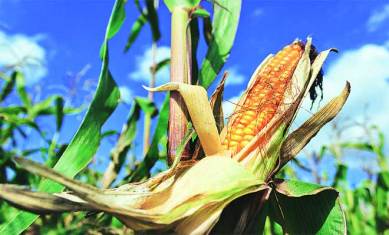Diverse first results
In Punjabs first season of crop diversification,basmati scores on all counts,maize and cotton lose on production but gain on prices.

In Punjabs first season of crop diversification,basmati scores on all counts,maize and cotton lose on production but gain on prices.
The first results of Punjabs efforts at crop diversification are out. The crops the state is seeking to move towards,such as maize and cotton,have gained in prices,though there has also been a setback with bad weather pulling production of both crops below what it was even before the diversification.
The target for maize is 5.5 lakh hectares in the next five years; the addition of 23,000 hectares raised the existing area from 1.29 lakh hectares to 1.52 lakh. Other five-year targets include 7 lakh hectares each for basmati and cotton,2.6 lakh hectares for sugarcane,3 lakh hectares for agroforestry,1.2 lakh hectares for pulses,and 1 lakh hectares for fruits etc.
Despite getting a larger field,maize and cotton have seen production dropping respectively by 24 and 29 per cent compared to the corresponding period last year. On the other hand,basmati has risen 55 per cent in terms of arrivals in mandis.
Basmati
All three crops,however,have fetched good prices this year. For basmati,the state government did not announce the minimum support price it had promised,yet farmers earned Rs 3,500 to Rs 5,700 per quintal for Pusa 1121 and Pusa 1509,which are disease-resistant and high-yielding varieties,according to Punjab Mandi Board sources. The prices last year were Rs 1,500 to Rs 3,000. According to the agriculture department,a farmer spends an average Rs 1,600 to Rs 1,800 on growing every quintal of basmati.
Last year by December 5,11.05 lakh tonnes basmati had arrived in various markets; this year until the same date,17.10 lakh tonnes have arrived. Sources in the Mandi Board project this years final basmati arrivals at 20 lakh tonnes against last years 14.85 lakh tonnes. The chief minister,in public speeches,has been calling on farmers to opt for basmati rather than paddy,and been directing officials to promote basmati and even exempted it of taxes.
Agriculture commissioner B S Sidhu says basmati growers earned well this season but stressed a focus on short-duration varieties to save groundwater and good marketing options to sustain diversification.
Farmer Jaswant Singh,among those diversifying,says the MSP for paddy was Rs 1,350 but half the farmers sold at Rs 1,000 to Rs 1,100 to private players due to high moisture in a prolonged rainy season. Basmati,on the other hand,sold at rates three to five times higher than those of paddy as it is sown and harvested later.
Mahinder Pal Singh of Jalandhar says he earned Rs. 80,000 to Rs 1 lakh from basmati grown on one acre,against Rs 40,000 to 45,000 paddy grown in the same area.
Maize
Maize arrivals till December 4 were 17.94 lakh quintals in 2013 against 23.30 lakh quintals in 2012,a year that had closed at 27.73 lakh quintals. But the farmers got Rs 1,000 to 1,500 per quintal,against Rs 750 to 850 last year,says Mandi Board general manager G P S Randhawa.
The government has distributed hybrid seeds at subsidy under the diversification policy. I grew maize on five acres but due to bad weather the entire crop got damaged and I sold it as fodder, says Joga Singh of Jandiala village in Jalandhar. But I earned well and will grow maize again; paddy is no longer profitable.
His maize crop had looked very good but was so tall it got in the way of strong winds. The agriculture department must recommend short varieties with high yield during the rainy season, suggests Randhawa,the Mandi Board GM.
The board has installed two first-of-their-kind-in-the-country maize driers,each of capacity 16 tonnes,to help boost the diversification policy. Maize is a high-moisture-content crop and driers can bring the content from 40 per cent to the required 14 per cent,says Randhawa,adding dried maize can be stored a long time and fetch good prices. We are planning to purchase smaller,6-tonne driers for installation across the state, he says. Jagtar Singh,who grows maize at Saila Khurad in Hoshiarpur,says using the drier helped him sell at prices he had never got before.
Cotton
Cotton till December 5 reached 13.95 lakh quintals in 2013 against 19.55 lakh quintals in 2012,a year that had closed at 83.36 lakh quintal,according to the Mandi Board. Farmers got good rates for cotton,too,thanks to procurement by the Cotton Corporation of India CCI at Rs 5,100 per quintal against the Rs 4,500 offered by private players. Last year,the rates were Rs 3,500 to Rs 4,000 per quintal.
The Centre has fixed the minimum support price at Rs 3,900 per quintal; what the CCI has offered is higher.
Where Punjab is lagging is in agro-forestry,pulses etc. The forest cover is just 7 per cent against a minimum requirement of 20 per cent,says agriculture commissioner Sidhu.
To review the first result of crop diversification,Punjab has constituted an expert committee under Punjab State Farmers Commission chairman G S Kalkat.
Having prepared a diversification programme of Rs 5,000 crore,the state has got Rs 224.50 crore for the first season from the agriculture ministry. The Centre had earmarked Rs 500 crore for promoting crop diversification during the current financial year.
Punjab got serious only after being pulled up by the Central Ground Water Board,which asked it to decrease around 10 lakh hectares under paddy,and comments from Agriculture Minister Sharad Yadav,who said Punjabs paddy may not be required for the central pool.
During the 2002-07 Congress regime in Punjab,too,an attempt at diversification had been made through contract farming. It failed and could not bring even 25 per cent of the targeted area under new crops. That plan was closed in 2012.